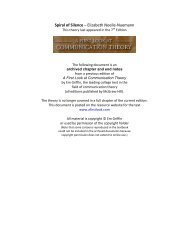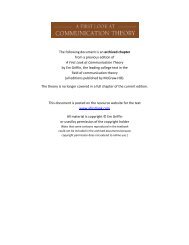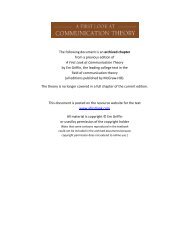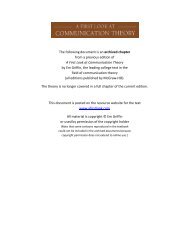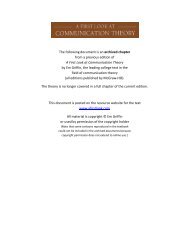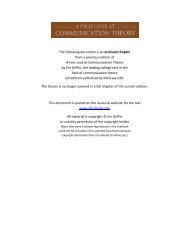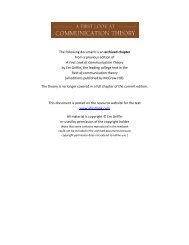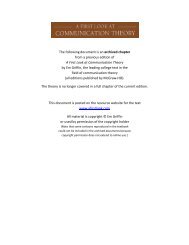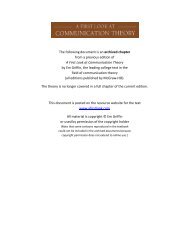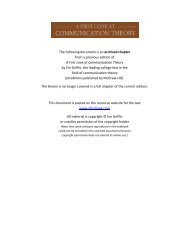Adaptive Structuration Theory of Marshall Scott Poole
Adaptive Structuration Theory of Marshall Scott Poole
Adaptive Structuration Theory of Marshall Scott Poole
Create successful ePaper yourself
Turn your PDF publications into a flip-book with our unique Google optimized e-Paper software.
Social structures<br />
Rules and resources <strong>of</strong> a<br />
group; characteristics<br />
such as composition,<br />
norms, communication<br />
networks, status hierarchies,<br />
task requirements,<br />
and peer pressure.<br />
CHA PTER 18: ADAPTIVE STRUCTURATION THEORY<br />
237<br />
in 1980 and extending throughout that decade, he sought to find out if and when<br />
ongoing groups actually conform to the single-sequence model when making<br />
tough decisions on important issues. <strong>Poole</strong> tracked 47 specific decisions made by<br />
29 different groups in natural settings- real people making real decisions. 3<br />
Early in his research, <strong>Poole</strong> discovered that only a quarter <strong>of</strong> the groups actually<br />
followed the discussion pattern laid out in the single-sequence model. But just as<br />
Hirokawa and Gouran <strong>of</strong>fer their functional perspective as a preferred procedure<br />
for task groups to adopt (see Chapter 17), <strong>Poole</strong> was still hopeful that the five phases<br />
<strong>of</strong>fered a blueprint for reaching high-quality decisions. He wrote that "the unitary<br />
sequence provides a logically ideal format for decision making and it may well be<br />
the simplest effective path a decision-making group could follow.,,4<br />
Yet the longer <strong>Poole</strong> examined the complexity <strong>of</strong> group decision making, the<br />
less optimistic he became that any theory or model would be able to predict a<br />
specific sequence <strong>of</strong> action. By the end <strong>of</strong> the decade, he was disenchanted with<br />
the scientific quest to discover a fixed pattern <strong>of</strong> group behavior. He became<br />
convinced that group dynamics are far too complicated to be reduced to a few<br />
propositions or a predictable chain <strong>of</strong> events. He also grew uncomfortable with<br />
the phase model's objectivist assumption that group and task structures dictate<br />
the way a decision is made. In effect, the model claims that communication has<br />
no significant impact on the process or the outcome; group members are just<br />
along for a five-stage ride.<br />
<strong>Poole</strong> continued to think that group members are affected by social structures<br />
such as group composition, communication networks, status hierarchies, task<br />
requirements, group norms, and peer pressure. But he no longer saw these structures<br />
as determining how the group reached a decision or what that decision<br />
might be. He was convinced that what people say and do makes a difference.<br />
Given this commitment, <strong>Poole</strong> and two other communication scholars, Robert<br />
McPhee (Arizona State University) and David Seibold (University <strong>of</strong> California,<br />
Santa Barbara), became intrigued by the work <strong>of</strong> British sociologist Anthony<br />
Giddens. Giddens suggests that people in society are active agents in the sense<br />
that they are "able to act otherwise" and have the capacity "to make a difference."s<br />
McPhee went on to apply Giddens' core ideas in an organizational context,<br />
while Seibold used them to analyze the structure <strong>of</strong> arguments. But in<br />
Giddens' macrotheory <strong>of</strong> societal structuration, <strong>Poole</strong> saw insights that could be<br />
adapted and applied to the microlevel <strong>of</strong> small-group activity.<br />
STRUCTURATION ACCORDING TO GIDDENS<br />
<strong>Structuration</strong><br />
The production and reproduction<br />
<strong>of</strong> socia I systems<br />
through group<br />
members' use <strong>of</strong> rules and<br />
resources in interaction.<br />
Currently the director <strong>of</strong> the London School <strong>of</strong> Economics, Anthony Giddens was<br />
the chief intellectual adviser to former British prime minister Tony Blair. Colleagues<br />
call him "the most important English social philosopher <strong>of</strong> our time.,,6 Giddens<br />
openly admits that structuration "is an unlovely term at best,,,7 yet he believes that<br />
no other word adequately captures the process <strong>of</strong> social structures shaping peopie's<br />
actions while at the same time being shaped by their actions. Specifically, st<br />
ructuration refers to "the production and reproduction <strong>of</strong> the social systems<br />
through members' use <strong>of</strong> rules and resources in interaction."s<br />
By using the word interaction, as opposed to the more passive term behavior,<br />
Giddens signals his belief that people are relatively free to act as they will. They<br />
aren't merely pawns in the game <strong>of</strong> life or unsuspecting dupes controlled by<br />
unseen forces they can't resist. He says that every social actor knows a lot about



